Abstract
For semi-fossorial rodents, descriptions of the distribution and use of burrows can advance in understanding the spatial and social organization of their population. This study describes the use and spatial relationships between burrows of the kangaroo rat (Dipodomys merriami insularis), a subspecies that is possibly on the verge of extinction. Individuals were captured and recaptured in an area of 79.8 hectares located at San José Island, Gulf of California, Mexico, during both the breeding (BRED, from March to May) and the non-breeding (NON-BRED, from October to November) seasons of 2008. Our results show that females and males use a median of 1–2 burrows; factors such as age class, season and frequency of captures account for the number of burrows used by individuals. Few individuals shared their burrows (9.2% during BRED and 1.1% during NON-BRED). The burrows showed a clumped spatial distribution in both sampling periods. The spatial relationship between burrows is characterized by the fact that animals of opposite sex are closer to each other than same-sex individuals, and this spatial relationship between nearest-neighbor burrows is influenced by age class. Our results show that D. m. insularis displays burrow use and spatial organization patterns similar to those observed in other populations of D. merriami.
Similar content being viewed by others
References
Álvarez-Castañeda, S.T., Ortega-Rubio, A., 2003. Current status of rodents on islands in the Gulf of California. Biol. Conserv. 109, 157–163.
Álvarez-Castañeda, S.T., Lidicker Jr., W.Z., Ríos, E.R., 2009. Revision of the Dipodomys merriami complex in the Baja California Peninsula, Mexico. J. Mammal. 90, 992–1008.
Behrends, P., Daly, M., Wilson, D.I., 1986. Range use patterns and spatial relationships of Merriamĭs Kangaroo rats (Dipodomys merriami). Behaviour 96, 187–209.
Best, T.L., 1972. Mound development by a pioneer population of the banner-tailed kangaroo rat. Dipodomys spectabilis baileyi Goldman, in eastern New Mexico. Am. Midl. Nat. 87, 201–206.
Best, T.L., Intress, C., Shull, K.D., 1988. Mound structure in three taxa of Mexican kangaroo rats (Dipodomys spectabilis cratodon D. s. zygomaticus and D. nelsoni). Am. Midl. Nat. 119, 216–220.
Best, T.L., Thomas, H.H., 1991. Dipodomys insularis. Mammal. Species 374, 1–3.
Brock, R.E., Kelt, D.A., 2004. Conservation and social structure of Stephens’ kangaroo rat: implications from burrow-use behavior. J. Mammal. 85, 51–57.
Caro, T., 1998. The significance of behavioral ecology for conservation biology. In: Caro, T. (Ed.), Behavioral Ecology and Conservation Biology. Oxford University Press, New York, pp. 369–393.
Clark, P.J., Evans, F.C., 1954. Distance to nearest neighbor as a measure of spatial relationships in populations. Ecology 35, 445–453.
Cody, M.L., Moran, R., Thompson, H., 1983. The plants. In: Case, T.J., Cody, M.L. (Eds.), Island Biogeography in the Sea of Cortez. University of California Press, Berkeley, pp. 49–97.
Cooper, L.D., Randall, J.A., 2007. Seasonal changes in home ranges of the giant kangaroo rat (Dipodomys ingens): a study of flexible social structure. J. Mammal. 88, 1000–1008.
Crawley, M.J., 2007. The R Book. The John Wiley & Sons, Ltd., Chichester, England, 511–526.
Daly, M., Behrends, P.R., Wilson, M.I., Jacobs, L.F., 1992. Behavioral modulation of predation risk moonlight avoidance and crepuscular compensation in a noctural desert rodent, Dipodomys merriami. Anim. Behav. 44, 1–10.
Espinosa-Gayosso, C.V., Álvarez-Castañeda, S.T., 2006. Status of Dipodomys insularis, an endemic species of San José Island, Gulf of California Mexico. J. Mammal. 87, 677–682.
Faraway, J., 2006. Extending the Linear Model with R. Chapman and Hall/CRC, New York.
Gannon, W.L., Sikes, R.S., Animal Care and Use Committee of the American Society of Mammalogists, 2007. Guidelines of the American Society of Mammalogists for the use of wild mammals in research. J. Mammal. 88, 809–823.
IUCN (International Union for Conservation of Nature and Natural Resources), 2009. 2009 1UCN Red list of threatened species. www.iucnredlist.org (accessed November 2009).
Jones, W.T., 1984. Natal philopatry in bannertailed kangaroo rats. Behav. Ecol. Sociobiol. 15, 51–155.
Jones, W.T., 1989. Dispersal distance and the range of nightly movements in Merriam’s kangaroo rats. J. Mammal. 70, 27–34.
Krebs, C.J., Boonstra, R., 1984. Trappability estimates for mark-recapture data. Can. J. Zool. 62, 2440–2444.
Maoh, H., 2001. Distance Matrix of Point Features (dmatrixen.avx) extension for ArcView 3.2a. Available at: http://arcscripts.esri.com/details.asp?dbid=10408.
Norma Oficial Mexicana (2002): Protección ambiental-especies nativas de México de flora y fauna silvestres-categorías de riesgo y especificaciones para su inclusión, exclusión o cambio-listade especies en riesgo. NOM-059-ECOL-2001. Diario Oficial de la Federación, Norma Oficial Mexicana, México City, Mexico.
O’Farrell, M.J., 1980. Spatial relationships of rodents in a sagebrush community. J. Mammal. 61, 589–605.
Perri, L.M., Randall, J.A., 1999. Behavioral mechanism of coexistence in sympatric species of desert rodents, Dipodomys ordii and D. merriami. J. Mammal. 80, 1297–1310.
Randall, J.A., 1987. Field observation of male competition and mating in Merriam’s and banner tail kangaroo rat. Am. Midl. Nat. 117, 211–213.
Randall, J.A., 1989. Neighbor recognition in solitary desert rodent (Dipodomys merriami). Ethology 81, 123–133.
Randall, J.A., 1991. Sandbathing to establish familiarity in the Merriam’s kangaroo rat, Dipodomys merriami. Anim. Behav. 41, 267–275.
Randall, J.A., 1993. Behavioural adaptations of desert rodents (Heteromyidae). Anim. Behav. 45, 263–267.
Randall, J.A., Hekkala, E.R., Cooper, L.D., Barfield, J., 2002. Familiarity and flexible mating strategies of a solitary rodent, Dipodomys ingens. Anim. Behav. 64, 11–21.
R Development Core Team, 2008. R: A language and environment for statistical computing. R Foundation for Statistical Computing, Vienna, Austria, ISBN 3-900051-07-0, http://www.R-project.org.
Reichman, O.J., Price, M.V., 1993. Ecological aspects of Heteromyid foraging. In: Genoways, H.H., Brown, J.H. (Eds.), Biology of the Heteromyidae. Special Publications No. 10. The American Society of Mammalogists, Utah, pp. 539–574.
Reichman, O.J., Smith, S.C., 1990. Burrows and burrowing behavior by mammals. In: Genoways, H.H. (Ed.), Current Mammalogy. Plenum Press, New York/London, pp. 197–244.
Reynolds, H.G., 1958. The ecology of the Merriam kangaroo rat (Dipodomys merriami Mearns) on the grazing lands of southern Arizona. Ecol. Monogr. 28, 111–127.
Salinas-Zavala, C.A., Leyva-Contreras, A., Lluch-Belda, D., Díaz-Rivera, E., 1990. Distribución geográfica y variabilidad climática de los regímenes pluviométricos en Baja California Sur, México. Atmósfera 3, 217–237.
Schooley, R.L., Wiens, J.A., 2001. Dispersion of kangaroo rat at multiple scales in New Mexico, USA. Landscape Ecol. 16, 267–277.
Schroder, G.D., 1979. Foraging behavior and home range utilization of the bannertail kangaroo rat (Dipodomys spectabilis). Ecology 60, 657–665.
Schroder, G.D., Geluso, K.N., 1975. Spatial distribution of Dipodomys spectabilis mounds. J. Mammal. 87, 748–756.
Shier, D.M., Randall, J.A., 2004. Spacing as a predictor of social organization in kangaroo rats (Dipodomys heermanni arenae). J. Mammal. 85, 1002–1008.
Vaughan, T.A., Ryan, J.A., Czaplewski, N.J., 2000. Mammalogy, fourth ed. Harcourt College Publishers, Philadelphia.
Winters, J.B., Waser, P.M., 2003. Gene dispersal and outbreeding in a philopatric mammal. Mol. Ecol. 12, 2251–2259.
Zeng, Z., Brown, J.H., 1987. Population ecology of a desert rodent: Dipodomys merriami in the Chihuahuan desert. Ecology 68, 1328–1340.
Author information
Authors and Affiliations
Corresponding author
Rights and permissions
About this article
Cite this article
Vázquez, J., Álvarez-Castañeda, S.T. Spatial relationships between burrows of an insular population of Dipodomys merriami. Mamm Biol 76, 577–582 (2011). https://doi.org/10.1016/j.mambio.2011.05.005
Received:
Accepted:
Published:
Issue Date:
DOI: https://doi.org/10.1016/j.mambio.2011.05.005




